|
Believe it or not, the patient has a job to do during an acupuncture session. Now, this job is not as obvious or as active as the job of the practitioner, but it is equally as important. Aside from simply taking a load off and resting on the table for a half hour or so, one of the most crucial things that you as the patient can do is pay attention, observe, or listen to yourself in a gentle, yet disciplined way. Let me allow Buddhist monk and author, Thich Nhat Hanh to elaborate. Below are passages taken from his book, The Heart of Buddha's Teaching: Transforming Suffering into Peace, Joy, and Liberation. Here, he outlines a practice for developing what is known in Buddhist teachings as Right Mindfulness, a practice that harmonizes and connects mind and consciousness with the physical body, which you will come to see were never really separate in the first place.
"In the Discourse on the Four Establishments of Mindfulness, the Buddha offers four objects for our mindfulness practice: our body, our feelings, our mind, and the objects of our mind... The Four Establishments of Mindfulness are the foundation of our dwelling place [and the foundation of the patient's practice during an acupuncture treatment]. Without them, our house is abandoned; no one is sweeping, dusting, or tidying up. Our body becomes unkempt, our feelings full of suffering, and our mind a heap of afflictions..." Mindfulness of the Body "The first establishment is 'mindfulness of the body in the body. Many people hate their bodies. The feel their body is an obstacle... When Sister Jina, a nun at Plum Village, teaches yoga, she always begins by saying, 'Let us be aware of our bodies. Breathing in, I know I am standing here in my body. Breathing out, I smile to my body.' Practicing this way, we renew our acquaintance with our body and make peace with it... We begin by noting all of our body's positions and movements. When we sit, we know we are sitting. When we stand, walk, or lie down we know we are standing, walking, or lying down... "The second way the Buddha taught us to practice mindfulness of the body is to recognize all of our body's parts, from the top of our head to the soles of our feet... We observe whether our forehead is relaxed and whether it has wrinkles. With mindfulness we touch our nose, our mouth, our arms, heart, lungs, blood and so on... "The third method for practicing mindfulness of the body is to see the elements that it is made of: earth, water, fire, and air [these elements are discussed slightly differently across different traditions, but the practice is the same regardless]... Earth refers to things that are solid, and when we see the earth element in us we realize that there is really no boundary between ourselves and the rest of the universe. Next, recognize the element of water within you [the cooling and nourishing qualities of body and mind]. After that, we recognize the fire element, which means heat. For life to be possible, there must be heat. The best way to experience the air element is to practice mindful breathing. 'Breathing in, I know I am breathing in. Breathing out, I know I am breathing out...' We don't try to control our breathing. Whether our in-breath is long or short, deep or shallow, we just breathe naturally and shine the light of mindfulness on it... Mindfulness of the Feelings "The second establishment is 'mindfulness of the feelings in the feelings.' Feelings is just one of the fifty-one kinds of mental formations. In us, there exists a river of feelings in which every drop of water is a different feeling. To observe our feelings, we just sit on the riverbank and identify each feeling as it flows by and disappears... When we have a pleasant feeling, we may have a tendency to cling to it, and when we have an unpleasant feeling, we may be inclined to chase it away. But, it is more effective in both cases to turn to our breathing and simply observe the feeling, identifying it silently... Our feelings are not separate from us or caused just by something outside of us. Our feelings are us, and, for that moment we are our feelings... If we face our feelings with care and affection, we can transform them into a kind of energy that is healthy and nourishing... We all have difficult emotions, but if we allow them to dominate us we will become depleted. Emotions become strong when we do not know how to look after them. When our feelings are stronger than our mindfulness, we suffer. But, if we practice conscious breathing day after day, mindfulness becomes a habit..." Incorporate these practices into your daily life, including the time you spend on a treatment table during an acupuncture session. Turn your attention to your body, checking in with each section from top to bottom. Then, give notice to how your breathing moves your body, and where it is able to reach in your body. Of great importance is learning to feel your breath move into your lower abdomen, below your belly button. Don't strain body nor mind during any of this. As Thich Nhat Hanh has said, "Smile, breath, and go slowly." Thanks for reading. Nhat Hanh, Thich. "Right Mindfulness." The Heart of Buddha's Teaching: Transforming Suffering into Peace, Joy, and Liberation. New York, Broadway Books, 1999, pp. 67-70.
0 Comments
|
This page is intended to serve as a source for links to blogs and articles about acupuncture and Chinese herbal medicine that both new and returning patients may find informative and/or entertaining. It is also where I will share information about the history, principles, and benefits of this awesome medicine. Archives
May 2023
|


 RSS Feed
RSS Feed